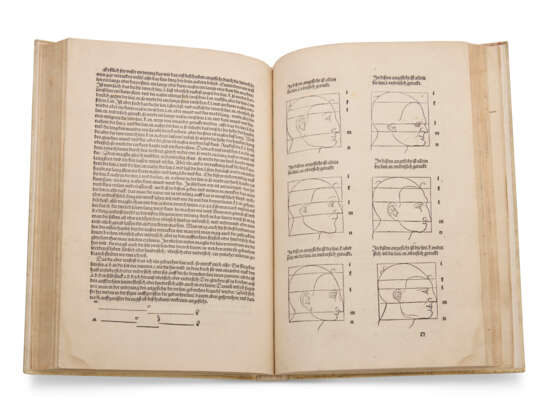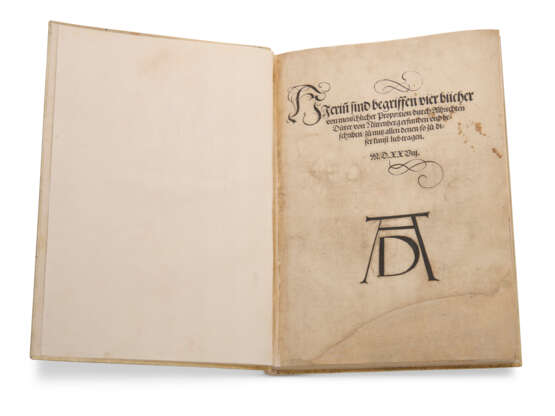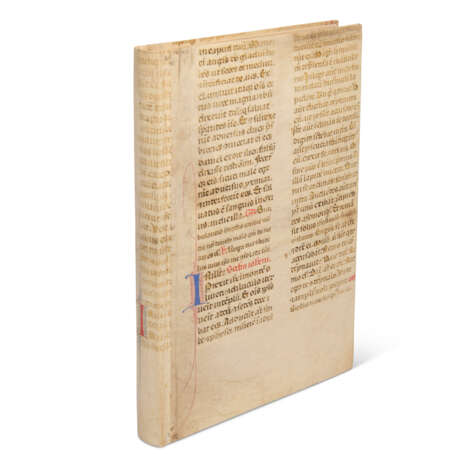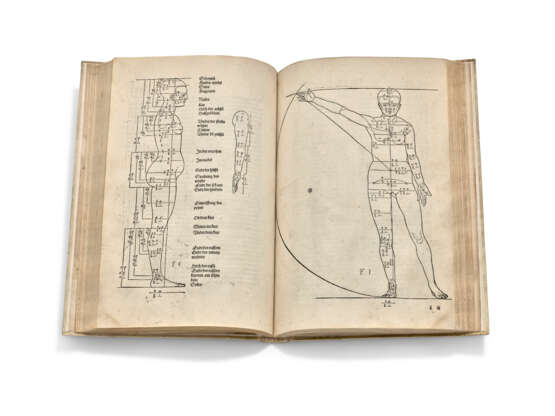ID 1450323
Los 72 | DÜRER, Albrecht (1471-1528)
Schätzwert
£ 20 000 – 25 000
Hierinn sind begriffen vier bücher von menschlicher Proportion. Edited by Willibald Pirckheimer. Nuremberg: Hieronymus Andreae Formschneider for Dürer's widow, 31 October 1528.
Anatomy in the Northern Renaissance: first edition of Dürer’s treatise on the geometry of the human body. Dürer’s ‘Four books on human proportion’ codifies his approach to figural representation: employing over 140 full-length studies of men, women and infants, along with a further c.35 vignettes including heads, hands, arms and feet, he elucidates the basic geometry to which the human form can be reduced. ‘Dürer held that the essence of true form was the primary mathematical figure (e.g., straight line, circle, curve, conic section) constructed arithmetically or geometrically, and made beautiful by the application of a canon of proportion. However, he was also convinced that beauty of form was a relative and not an absolute quality; thus the purpose of his system of anthropometry was to provide the artist with the means to delineate, on the basis of sheer measurement, all possible types of human figures. The first two books of Dürer's work deal with the proper proportions of fat, medium and thin adult figures, as well as those of infants. The third book discusses the changing of proportions according to mathematical rules, applying these rules to both figures and faces. The fourth book treats of the movement of bodies in space, and is of the greatest mathematical interest, as it presents, for the first time, many new, intricate and difficult considerations of descriptive spatial geometry. The whole work is profusely illustrated with Dürer's woodcut diagrams of figures. Choulant states that these include "the first attempts to represent shades and shadows in wood engraving by means of cross-hatching”’ (Norman).
‘On human proportion’ was written, illustrated and designed by Dürer; the preliminary work for the book goes back about two decades, while proportional studies from around 1500 suggest that this topic occupied him for much of his adult life. He began to study the mathematics of form during his travels to Italy, where artist-theorists such as Leon Battista Alberti and Leonardo da Vinci had worked extensively on the subject: we know that on one of his visits to Italy Dürer must have viewed some of Leonardo's anatomical drawings, for he copied one into his Dresden Sketchbook. His treatise was completed at the end of 1527 or beginning of 1528 and handed over to the printer at that time. He died before seeing it to completion: the work was published posthumously under the auspices of his widow, Agnes, later that year. Dürer dedicated the book to his friend Willibald Pirckheimer, who provides the preface describing Dürer's debt to the Italians and explaining Dürer's influence, in turn, on Italian and European art. Dürer's original drawings for this work are still preserved in his Dresden Sketchbook. Choulant-Frank, pp. 141-147; Garrison-Morton 149; Meder p. 288; Norman 666; Albrecht Dürer : das druckgraphische Werk, vol III (2001), pp.319-473.
Folio (280 x 186mm). Collation: A-M6 N4 O4 (O1 + double-page folding leaf signed ‘O2’, O2-O3 signed ‘O3-O4’) P-R6 S4 (S3 + double-page folding leaf signed ‘S4’ + another double-page folding leaf, unsigned) T4 V-X6 Y4 (Y2 + double-page folding leaf signed ‘Y3’) Z6. 128 leaves, plus four folding sheets printed on both sides. Gothic type, mostly double-column. Dürer's large woodcut monogram on title, c.143 full-length proportional woodcuts of human figures, many two to a page, and c.35 smaller, geometrical or proportional woodcut diagrams, some of individual body parts (heads, arms, hands or feet), Fraktur initials, flourished woodcut tail-piece ornaments, colophon on verso of Z3 (Title soiled and piece at foot replaced, A2 hinges and edges repaired, some further repairs, including the folding plates and corner of Z4 corner, water-staining more pronounced in A and B, further browning). Provenance: early marginal annotations in a German hand and portrait of a man added to the verso of title.
| Künstler: | Albrecht Dürer (1471 - 1528) |
|---|---|
| Herkunftsort: | Westeuropa, Deutschland, Europa |
| Kategorie des Auktionshauses: | Medizin und Wissenschaft, Bücher und Handschriften, Gedruckte Bücher |
| Künstler: | Albrecht Dürer (1471 - 1528) |
|---|---|
| Herkunftsort: | Westeuropa, Deutschland, Europa |
| Kategorie des Auktionshauses: | Medizin und Wissenschaft, Bücher und Handschriften, Gedruckte Bücher |
| Adresse der Versteigerung |
CHRISTIE'S 8 King Street, St. James's SW1Y 6QT London Vereinigtes Königreich | |
|---|---|---|
| Vorschau |
| |
| Telefon | +44 (0)20 7839 9060 | |
| Aufgeld | see on Website | |
| Nutzungsbedingungen | Nutzungsbedingungen |














